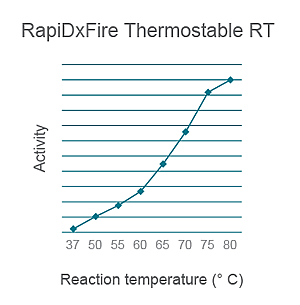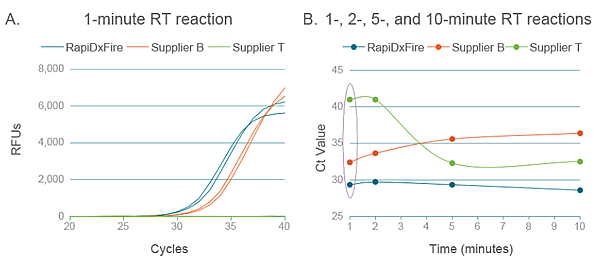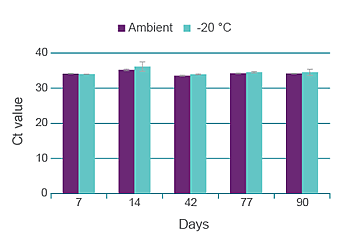RapiDxFire Thermostable Reverse Transcriptase
Truly Thermostable Reverse Transcriptase for fast synthesis of short cDNA (< 1 Kb)
Product Description
RapiDxFire™ Thermostable Reverse Transcriptase is a significant advancement over popular MMLV- and AMV reverse transcriptases. Originally identified in hot springs, this robust bacteriophage enzyme exhibits increasingly high activity at elevated temperatures (~60% activity remains after 10 min at 90⁰C) and maintains its core activity after >3 months storage at 20-25⁰C.
This enzyme lacks RNAse H and 3’ 5’ exonuclease activity and efficiently synthesizes short cDNA fragments (≤ 1 Kb). Like other reverse transcriptases, RapiDxFire Reverse Transcriptase possesses DNA polymerase activity but lacks 5'->3' exonuclease activity. Supplied in a glycerol-free, Triton™ X-100-free storage buffer, the enzyme formulation can be further optimized for downstream lyophilization.
- Extremely active at high temperatures (55 to 80°C)
- Detection of ≤100 copies of RNA in two-step RT-qPCR assays
- Short reaction time (5 minutes or less)
- Stable at room temperature for more than 3 months
- Lyo-compatible - glycerol-free enzyme formulation
- Batch to batch reproducibility
- Manufactured in an ISO 13485-certified facility
- Concentration of 3 u/ul
RapiDxFire Thermostable RT Performs Best at High Temperatures

Figure 1. Reaction temperature profile for RapiDxFire Thermostable Reverse Transcriptase. Reverse transcription reactions were set up on ice using each manufacturer’s recommended buffer system and Poly (rC) /p(dG)12-18 template/primer substrate. Reactions were transferred from ice to the indicated temperatures (37, 50, 55, 60, 65, 70, 75, and 80°C) and incubated for 40 minutes. Following incubation, RNA/cDNA heteroduplex product is quantified as a measure of polymerization activity, utilizing PicoGreen® fluorescence on a Tecan Infinite® M1000 Pro. RapiDxFire Thermostable RT exhibits increasing activity as the reaction temperature is increased, up to 80ºC (highest temperature tested); ~60% activity remains after 10 min at 90⁰C (data not shown).
Superior Detection of Zika virus with RapiDxFire Thermostable RT

Figure 2. cDNA synthesis time course studies in a 2-step RT-qPCR reaction with different thermostable RTs. A) qPCR curve after a 1 minute reverse transcription reaction. Zika cDNA synthesis was conducted for each enzyme in duplicate using target-specific primers and recommended reaction buffer and incubation temperatures per suppliers’ guidelines (RapiDxFire= 60⁰C, Supplier B= 50⁰C, and Supplier T= 55⁰C). After cDNA synthesis real time PCR was performed using one-tenth volume of each of the cDNA samples. PCR was performed using EconoTaq and its supplied buffer (Lucigen Cat No. 30031-3). Detection of PCR products were done real time using an intercalating dye (Dyomics Cat No. V13-01184) and BioRad CFX C1000 Touch™ with absorption/emission of 481nm/526nm. B) Reverse transcription time course study prior to performing second-step real-time PCR. Encircled data points are derived from data represented in the qPCR curve in A).
3-month Room Temperature Stability

Figure 3. RapiDxFire Thermostable Reverse Transcriptase was stored in separate aliquots per time point at ambient and -20°C. At each time point RapiDxFire Thermostable RT was evaluated by measuring first-strand cDNA synthesis of 10000 copies MS2 RNA. cDNA synthesis was carried out using a gene-specific primer for MS2 at reaction temperature of 60°C for 5 minutes. cDNA was measured using real time PCR and MS2 primers design around a 520 base pair amplicon.
- Catalog Number
30250-1-LU - Supplier
Lucigen - Size
- Shipping
Blue Ice

